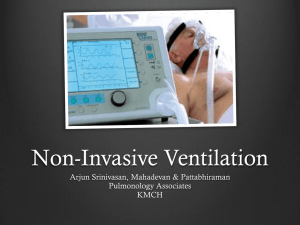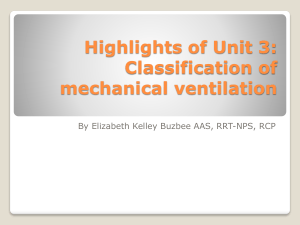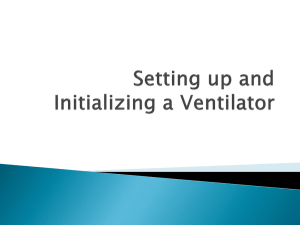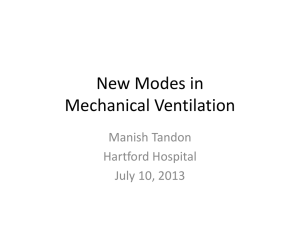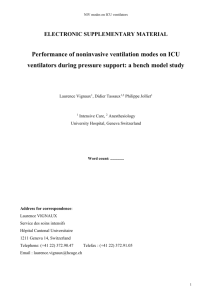Mechanical Ventilation
advertisement
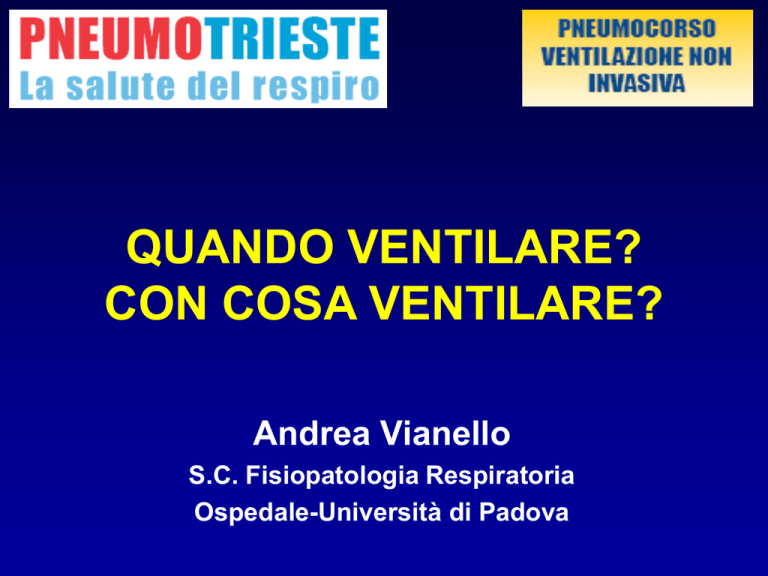
QUANDO VENTILARE? CON COSA VENTILARE? Andrea Vianello S.C. Fisiopatologia Respiratoria Ospedale-Università di Padova RESPIRATORY FAILURE LUNG FAILURE PUMP FAILURE GAS EXCHANGE FAILURE VENTILATORY FAILURE HYPOXEMIA HYPERCAPNIA What’s the point of ventilation? – Deliver O2 to alveoli • Hb binds O2 (small amount dissolved) • CVS transports to tissues to make ATP - do work – Remove CO2 from pulmonary vessels • from tissues - metabolism Why ventilate?- purposes • To maintain or improve ventilation, & tissue oxygenation. • To decrease the work of breathing & improve patient’s comfort. When ventilate?- indications • Failure of pulmonary gas exchange – Hypoxaemia: low blood O2 • “Mechanical” failure – Hypercarbia: high blood CO2 – Respiratory muscle fatigue • Need to intubate eg patient unconscious • Others eg – need neuro-muscular paralysis to allow surgery – cardiovascular reasons Non-Invasive Ventilation “a form of ventilatory support that avoids airway invasion” Hill et al Crit Care Med 2007; 35:2402-7 Paziente con riacutizzazione acidotica di BPCO Terapia medica + O2 q.b. per SpO2 89-92% Airway narrowing & obstruction Airway Inflammation AutoPEEP Shortened muscles curvature muscle strength Frictional WOB Elastic WOB Gas trapping VT VA VE PaCO2 pH PaO2 VCO2 usa i farmaci e bene ! Airway Inflammation Steroids Abx Shortened muscles curvature BDs Frictional WOB AutoPEEP Elastic WOB Gas trapping Teophylline muscle strength Airway narrowing & obstruction VT VA VE PaCO2 pH PaO2 VCO2 usa i farmaci e bene ! Airway Inflammation Steroids Abx Shortened muscles curvature BDs Teophylline muscle strength Airway narrowing & obstruction MV PEEP AutoPEEP Elastic WOB Gas trapping VT VE MV VA Frictional WOB PaCO2 pH PaO2 MV VCO2 Paziente con riacutizzazione acidotica di BPCO Terapia medica + O2 q.b. per SpO2 89-92% Ripetizione di EGA pH > 7.35 NIV non indicata >7.30 pH < 7.35 pH < 7.30 pH < 7.20 NIV consigliata l’80% dei pazienti migliora comunque con terapia standard Ogni 10 pazienti trattati con NIV si evita 1 ETI; NIV migliora la dispnea NIV altamente consigliata Senza NIV 1 paziente su 2 necessita di ETI NIV migliora la sopravvivenza NIV altamente consigliata 1 paziente su 2 fallisce NIV Tuttavia con NIV migliora outcome ospedaliero e sopravvivenza a 1 anno NIV VS TRATTAMENTO STANDARD Keenan S et al NIV VS TRATTAMENTO STANDARD Keenan S et al NIV VS TRATTAMENTO STANDARD Keenan S et al The ICU studies • Confirm the feasibility of NIV • Confirm the effectiveness of NIV • Selected patients / enthusiastic Units • Reduced complications particularly infectious – 16% v 48% 1 ,18 v 60% 2 • Reduce ICU / Hospital stay – 23 v 35 days 1 , 9 v 15 days 2 1. Brochard et al NEJM 1995; 333:817-22 2. Girou et al JAMA 2000; 284:2361-7 2005; 128 49 pazienti con IRA in BPCO dopo fallimento terapia medica, pH 7.2 • Simili durata di permanenza in ICU, durata VM, complicanze generali, mortalità in ICU, e mortalità in ospedale • con NIV 48% evitano ETI, sopravvivono con permanenza in ICU inferiore vs pazienti VM invasiva (P=0.02) • A 1 anno: NIV inferiore riospedalizzazione (65% vs 100% P=0.016) e minor frequenza di riutilizzo supplemento di ossigeno (0% vs 36%) Studio caso-controllo: 64 paz. con IRA trattati con NIV pH = 7.18 • 40/64 (62%) fallimento NIV (RR con NIV - 38%) • Simili mortalità in ICU, e mortalità in ospedale; durata di NIVin riduce di ETI e permanenza ICU e postnecessità ICU, ma: ospedalizzazione, migliora outcome a lungo • Inferiori complicanze (P=0.01) e probabilità di rimanenere in VM (P=0.056) termine • Se NIV efficace (24/64 = 38%) migliore sopravvivenza e ridotta permanenza in ICU vs pazienti VM invasiva Definition: What is it? • Mechanical Ventilation =Machine to ventilate lungs = move air in (+ out) – Several ways to..move air in (IPPV vs others) Intermittent Positive Pressure Ventilation Definition: What is it? • Mechanical Ventilation =Machine to ventilate lungs = move air in (+ out) – Several ways to..move air in (IPPV vs others) Intermittent Positive Pressure Ventilation – Several ways to connect the ventilator to the patient Several ways to connect the machine to patient • Oro-tracheal Intubation • Tracheostomy • Non-Invasive Ventilation Normal breath Normal breath inspiration, awake Lung @ FRC= balance -2cm H20 Diaphragm contracts Chest volume Pleural pressure -7cm H20 Air moves down pressure gradient to fill lungs Alveolar pressure falls La pompa diaframmatica genera P garantendo la ventilazione polmonare, regolata da: Equazione di moto del Sistema Respiratorio: Pmusc = V / C + V’ x R Normal breath Normal breath expiration, awake -7cm H20 Diaphragm relaxes Pleural / Chest volume Pleural pressure rises -2cm H20 Air moves down pressure gradient out of lungs Alveolar pressure rises Ventilator breath Portable ventilator ICU ventilator ICU ventilator Ventilator breath Ventilator breath inspiration 0 cm H20 lung pressure Air blown in Air moves down pressure gradient to fill lungs +5 to+10 cm H20 Pleural pressure Il ventilatore sostituisce totalmente o parzialmente la pompa muscolare: Equazione di moto del Sistema Respiratorio: Pappl (+ Pmusc) = V / C + V’ x R Ventilator breath Ventilator breath expiration Similar to spontaneous…ie passive Ventilator stops blowing air in Air moves out Down gradient Pressure gradient Alveolus-trachea Lung volume Practicalities • Ventilator settings: • Pressure vs volume • ‘Assist’ vs ‘Control’ • Trigger sensitivity • PEEP? Details: Inspiration Pressure or Volume? • Do you push in.. – A gas at a set pressure? = ‘pressure…..’ – A set volume of gas? = ‘volume….’ Details: Inspiration Pressure cm H20 Pressure or Volume? Pressure cm H20 Time Time Pressure Ventilators • The use of pressure ventilators is increasing in critical care units. • A typical pressure mode delivers a selected gas pressure to the patient early in inspiration, and sustains the pressure throughout the inspiratory phase. • By meeting the patient’s inspiratory flow demand throughout inspiration, patient effort is reduced and comfort increased. • Although pressure is consistent with these modes, volume is not. • Volume will change with changes in resistance or compliance • Therefore, exhaled tidal volume is the variable to monitor closely. • With pressure modes, the pressure level to be delivered is selected, and with some mode options, rate and inspiratory time are preset as well. Details: Inspiration Pressure or Volume? Volume Ventilators • The volume ventilator has been historically used in critical care settings • A respiratory rate, inspiratory time, and tidal volume are selected for the mechanical breaths. • The basic principle of this ventilator is that a designated volume of air is delivered with each breath. • The amount of pressure required to deliver the set volume depends on : - Patient’s lung compliance - Patient–ventilator resistance factors Peak Inspiratory Pressure (PIP ) must be monitored in volume modes because it varies from breath to breath 30 Peak Inspiratory Pressure Paw cmH2O 1 -10 2 Time (s) 3 Details: Pressure vs Volume in the Acute Setting Secretions hypoventilation partial compensation sensitive Vt preserved hypoventilation insensitive Schönhofer ERS Monograph 2001; 16: 259-73, mod Details: leak compensation without leakage with leakage small leak huge leak Pre-set Pressure Vol Pressure Vol Mehta et al. Eur Respir J 2001; 17: 259-267 Interaction Respiratory muscle pump Ventilator Ventilator Respiratory muscle pump . . work of breathing spontaneous assisted controlled Oxygen consumption mL x min -1 Noninvasive mechanical ventilation in acute exacerbation of restrictive thoracic disease 250 200 CMV PSV SB SBT 150 100 50 0 1 2 Patient Eur Respir Mon 2001; 6:70-73 4 Phases Pressure 1. Inspiratory triggering 2. Inspiration Flow 3. Termination of inspiration Volume 4. Expiration Time Nilsestuen et al. Respir Care 2005; 50:202-232 Details: trigger sensitivity trigger asynchrony insensitive trigger • trigger sensitivity to low • high level of PSV • hypercapnic encephalopathy • sedation • sleep • intrinsic PEEP (COPD) • tubing obstruction sensitive trigger autotriggering • trigger sensitivity to high • resistance changes • tubing leakage • cardiac oscillation Trigger poco sensibile: allo sforzo inspiratorio non segue l’atto meccanico del respiratore Trigger troppo sensibile: l’atto meccanico si innesca spontaneamente Pao patient 1 patient 2 patient 3 Pes Asynchrony between patient and ventilator Problems: • Increased work of breathing • Need for sedation • „Fighting the ventilator“ • Ventilation-Perfusion-Mismatch • Dynamic hyperinflation Consequences: • Insufficient ventilation • Withdrawal from NIV • Weaning failure • Prolonged ICU stay • Costs Prognosis ! PSV L’operatore imposta: - pressione inspiratoria - sensibilità trigger - eventuale “rampa” (tempo di raggiungimento PS) - pressure-controlled - flow-cycled - patient-triggered Caratteristiche: - > sincronismo paziente-ventilatore > comfort - possibile graduazione sforzo inspiratorio lenta media rapida Diversi tipi di rampa PSV Problemi: - difficoltà di impostazione - livello PS VT: 6-8ml/Kg; RR: 20-35b/min P0.1: 2-4 cm H2O abolizione dissincronismi toracoaddominali - possibile sovrassistenza A-CV L’operatore imposta: Caratteristiche: Problemi: -volume corrente -frequenza respiratoria -rapporto I/E -sensibilità del trigger -volume-controlled -time-cycled -machine e/o patient-triggered (assistito) -pressure-limited (eventuale) - volume corrente insufflato garantito - rapporto I/E variabile - possibile sovrassistenza alcalosi respiratoria - insorgenza di PEEP intrinseca A-CV Hybrid modes combine the advantages of pressure pre-set and volume pre-set VAPS Volume Assured Pressure Support • Automatic adjustment of inspiratory pressure (range setting) • Target volume set • Measurement of inspiratory pressure and expiratory volume • Calculation of missing inspiratory volume • Increase of inspiratory pressure Assurance of tidal volume + comfort of pressure pre-set VAPS Volume Assured Pressure Support VAPS Volume Assured Pressure Support Storre et al. Chest 2006;130: 815-821 • AVAPS provides elegant adjustments of inspiratory pressures according to a pre-set target volume • AVAPS improves quality of ventilation • Improvements of sleep quality and quality of life are comparable to BiPAP-S/T • However: Sleep quality is not completely normalized • Further studies are needed Storre et al. Chest 2006; 130: 815-821 Efficacy and comfort of Volume-Guaranteed Pressure Support (PSV-VTG) in patients with chronic ventilatory failure of neuromuscular origin Efficacy and comfort of Volume-Guaranteed Pressure Support (PSV-VTG) in patients with chronic ventilatory failure of neuromuscular origin Efficacy andof comfort of Volume-Guaranteed Pressure Four types asynchronies: Support (PSV-VTG) in patients ventilatory • Ineffective inspiratory effortwith (IE):chronic thoracofailure of neuromuscular origin abdominal displacements not assisted by the ventilator positive pressure boost; • Inspiratory trigger delay: a time lag between the initiation of the patent’s IE and the onset of inspiratory support; • Prolonged inspiration or late expiratory cycling (hang-up): prolongation of mechanical insufflation beyond the end of patient inspiration; • Autotriggering: rapid succession of at least three pressurizations at a RR of >40 br/min. Efficacy and comfort of Volume-Guaranteed Pressure Support (PSV-VTG) in patients with chronic ventilatory failure of neuromuscular origin Pressure cm H20 Details: PEEP? PEEP Time Positive End Expiratory Pressure Effects of PEEP Normal, Awake – – in expiration alveoli do not close (closing capacity) change size Lying down / Paralysis / +- pathology – – – Lungs smaller, compressed Harder to distend, starting from a smaller volume In expiration alveoli close (closing capacity) PEEP – – – Keeps alveoli open in expiration Danger: applied to all alveoli Start at higher point on ‘compliance curve’ Effects of PEEP ‘over-distended’ alveoli Compliance= Volume Volume Pressure energy needed to open alveoli ?damaged during open/closing Pressure - abnormal forces Effects of PEEP Compliance= Volume Volume Pressure PEEP: start inspiration from a higher pressure Pressure Raised ‘PEEP’ ↓?damage during open/closing Regional ventilation: PEEP Spontaneous, standing ‘over-distended’ alveoli Compliance= Volume Volume Pressure Pressure Regional ventilation: PEEP Mechanical Ventilation Compliance= Volume Volume Pressure Pressure Details: Cardiovascular effects • Compresses Pulmonary vessels • Reduced RV outflow • Reduced LV inflow Details: Cardiovascular effects • Compresses Pulmonary vessels • Reduced LV inflow – Cardiac Output: Stroke Volume – Blood Pressure = CO x resistance – Blood Pressure – Neurohormonal • Reduced RV outflow- backtracks to body – Head- Intracranial Pressure – Others - venous pressure Vent settings to improve <oxygenation> PEEP • Increases FRC • Prevents progressive atelectasis and intrapulmonary shunting • Prevents repetitive opening/closing (injury) • Recruits collapsed alveoli and improves V/Q matching • Resolves intrapulmonary shunting • Improves compliance • Enables maintenance of adequate PaO2 at a safe FiO2 level • Disadvantages • Increases intrathoracic pressure (may require pulmonary a. catheter) • Rupture: PTX, pulmonary edema PEEP: Indications Clinical • • • • • Auto-PEEP Cardiogenic pulmonary edema (↑ LV preload) Hypoxemia with FIO2 > 0.5 Collapsing alveoli (ARDS, postop atelectasis) Chest wall instability (chest trauma) Physiological • • • • PaO2 < 60 mm Hg on FIO2 0.8 PaO2 ↑ < 10 mm Hg with FIO2 F of 0.2 PA-aO2 > 300 on FIO2 1.0 Shunt > 30% NIV treatment: summary • The ventilator management of NIV is continuously evolving; • New ventilators are introduced, offering novel features; • Clinical applications have been expanding; • Clinicians must make selections that best match the ventilator with the patient’s requirements.


